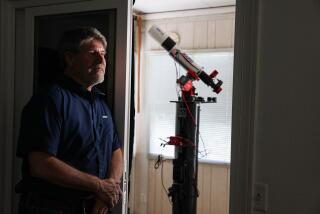Catch a Shining Star
- Share via
. . .When all at once, I saw a crowd,
A host, of golden daffodils;. . .
Continuous as the stars that shine
And twinkle on the Milky Way
--William Wordsworth, “Daffodil”
*
Stars twinkle.
With possibility, like a wink from the evening sky.
Who does not love the dance of a star? Poets do (see Wordsworth). The Bible does (“When they saw the star, they rejoiced with exceeding great joy”). Artists do (Van Gogh’s “Starry Night”).
And then there are astronomers.
At first we mourned the news that an astronomer was developing a technique to take the twinkle out of stars; this seemed like something from the Annals of Science Going Too Far.
But, says astronomer Ron Dantowitz, if he stills their movement, he can get a better look. Dantowitz is using the 100-inch-diameter telescope at Mt. Wilson, in the mountains above Pasadena, hoping to perfect his process for amateurs. (Some pros already attach expensive star-steadying devices to their telescopes.)
Extinguish the twinkle of a star? What’s next? we wondered.
In the name of science, should we zap the twirl out of fall leaves?
How about weaning the shimmer out of moonbeams on a lake?
Dantowitz, an astronomy educator at the Boston Museum of Science and a regular visitor to Mt. Wilson, is a man of good humor, and he breaks the science to us gently.
With the atmosphere in constant motion, he says, we get an unsteady view of the stars. This upsets astronomers. They spend long nights at big telescopes, waiting for the atmosphere to settle down. Picture what happens, says Dantowitz, when you pitch a penny into a pond, for instance--you wait for the water to stop moving and then take a look.
Now picture our earnest astronomer as a kid. At 13, Dantowitz’s dad gave him a telescope that presented a fair to middlin’ view of Saturn. But every once in awhile, he’d catch a glimpse of the planet when the atmosphere was at rest. . . .
“When you see Saturn as big as a basketball in front of you, it’s phenomenal,” says Dantowitz, 34. “I wanted to be able to exploit those ‘perfect seeing moments.’ ”
Here’s how his technique works: A video camera attached to the telescope’s eyepiece snaps 60 images a second. A software program sorts through thousands of the frames, tosses out the bad ones, and within minutes a combination of the sharpest images appears on a computer screen--voila--a twinkle-free star.
Dantowitz hasn’t thought about marketing the process. For now, he’ll keep refining the software program, and try to figure out how educators at museums and schools can duplicate it by using their own equipment.
The goal (for which he has spent more than $10,000 of his own)? He wants kids to tap into the wonder that he remembers from his first telescope--the one that was taller than he was, the one that he keeps in his office to this day.
With this, we hang up the phone, clucking at our journalistic skepticism. Dantowitz is not really an anti-twinkler after all.
The stars, in fact, have no greater lover than someone who wants them to shine with all their might.
More to Read
Sign up for The Wild
We’ll help you find the best places to hike, bike and run, as well as the perfect silent spots for meditation and yoga.
You may occasionally receive promotional content from the Los Angeles Times.






